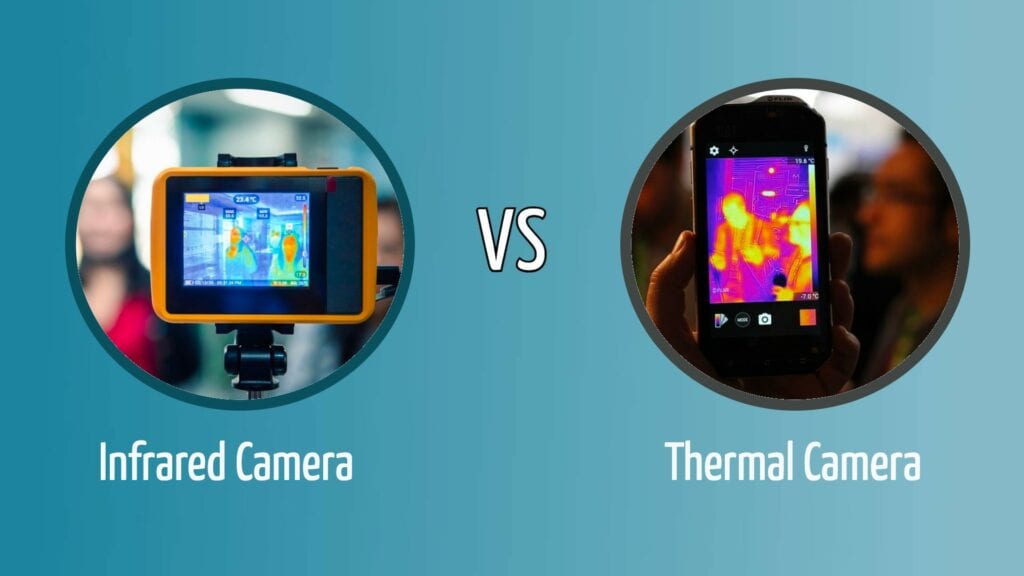Infrared vs. Thermal Cameras: How Are They Different?
Last Updated on

The camera has evolved dramatically in recent years. First, it was just about capturing images. Then, it became a matter of refining them and recording videos. A significant breakthrough was the development of night vision photography during World War II. The military used the competitive edge it gave them to spot enemies during the night, taking away the advantages of a nocturnal surprise attack.
Now, we have devices that tap into the potential of infrared imaging. They involve light wavelengths that lie outside of humans’ visible spectrum. The difference between infrared and thermal is nuanced. It may even seem trivial to people unfamiliar with this technology. While slight, the variations are significant with the various uses of these cameras.

Overview of Infrared Camera:

You’ll see infrared and thermal used interchangeably to describe these devices. They use similar energy sources but work in different ways to capture images. As they say, the devil is in the details.
How Infrared Cameras Work
The primary difference is the wavelength when considering how infrared and thermal cameras work. Infrared cameras use short wavelengths longer than visible light that reflects some light back to the device when capturing images. It is a non-contact device that supplies information about the wavelength of light from 0.7–300 micrometers. You may see IR thermometers that give a single real-time reading as well. The info the cameras record is outside of what you can see with the naked eye.
Uses for an Infrared Camera
Infrared cameras are the next step from night vision, which is an outdated technology. It bolsters the ambient light to make objects visible using the device from the light reflected back to it. You can think of it as a night-vision camera on steroids. It only operates in the stated wavelength range. It has many uses, from law enforcement to astronomy to hunting.
- Effective for night use
- Art restoration applications
- Use in medical procedures
- Potential for eye damage
- Not as much detail
- Distortions from reflected light

Overview of Thermal Camera:

Every living or non-living object generates a heat signature that an infrared camera can record. A thermal camera can capture the differences between a subject and its environment.
How a Thermal Camera Works
The result is an image that provides details of the temperature variations in relation to its surroundings and its absolute temperature in degrees Kelvin. It gives more information than an infrared camera, which increases its value and usability. While active IR uses short wavelengths, thermal imaging relies on mid to long-wavelengths.
Uses for a Thermal Camera
The temperature gradients this device detects speak to its varied uses. Meteorologists can use it to determine weather patterns. As you may surmise, it also has applications in hunting and law enforcement. Either can detect its prey even in low-light conditions with thermal imaging. Living things give off heat that is detectable by a thermal camera. While prices have dropped, these devices are still quite expensive, putting them out of the range of casual users.
- Less risk of eye injuries
- More information for positioning objects
- Easy-to-read display
- Unaffected by reflected light sources
- Expensive
Other Factors to Consider
Either type of device provides valuable information in their respective contexts. The overriding advantage of both is that they allow non-contact detection. That makes it possible to investigate sensitive areas, such as archaeological sites, without any risks of damaging evidence. Thermal imaging makes non-invasive diagnosis possible, making these procedures safer.
Infrared imaging rifle scopes also help hunters take prey more efficiently by making identification easier. It’s less expensive than thermal technology yet provides enough information for individuals in the field. Scientists have only scratched the surface of the uses of the latter. It has possible applications in firefighting, building inspections, and defense.

Final Thoughts
Infrared and thermal cameras make use of this energy spectrum, albeit in slightly different ways. The former makes things that are hard to see more visible by using night-vision technology in new applications. The latter provides a more complete picture of an object in certain situations, which makes further analysis possible and opens up new avenues for its uses. Therein lies the value of this exciting development in the camera.
Featured Image Credit: (L) PongMoji, Shutterstock (R) CAT S60 phone with Flir thermal camera (Image Credit: Maurizio Pesce from Milan, Italia, via Wikimedia Commons CC BY 2.0)
About the Author Chris Dinesen Rogers
Chris has been writing since 2009 on a variety of topics. Her motto with all of her writing is “science-based writing nurtured by education and critical thinking.” Chris specializes in science topics and has a special love for health and environmental topics, and animals of all shapes and sizes.
Related Articles:
Holy Stone Drone Review of 2024 – Pros, Cons, and Verdict
Ultraviolet Light vs Black Light: What’s the Difference?
Light Waves vs. Sound Waves: The Key Differences
Far Infrared vs Near Infrared: What’s The Difference?
Mottled Duck vs. Mallard vs. Black Duck: What’s the Difference?
Shutter Speed vs Frame Rate: Pros, Cons, & Difference
Oriole vs Goldfinch: How to Tell the Difference
Grey Heron vs Great Blue Heron: How To Tell the Difference
